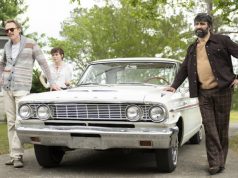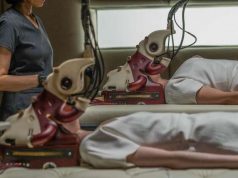You might feel compelled to see “The Interrupters” for one of two reasons. One is that it was directed by Steve James, the socially conscious filmmaker whose documentaries include “Hoop Dreams,” “Stevie,” and “At the Death House Door.” The other potential selling point is the subject matter: “The Interrupters” covers a year in the life of a Chicago organization dedicated to stopping urban violence among teenagers.
This is a fine film for educators and others who work with at-risk youth, or for anyone else passionate about the subject matter. Steve James’ fans — yes, documentarians have fans — will likewise not be disappointed. For the more casual doc-watcher, the film’s running time may be daunting. It’s definitely an exhausting experience, albeit a rewarding and inspiring one.
The organization, called CeaseFire, was founded by Gary Slutkin, a medical doctor and epidemiologist who took a scientific approach to reducing inner-city violence. The spread of disease is stopped more effectively by changing people’s behavior to keep them from getting sick than by administering antibiotics to those already infected; Slutkin theorized that the plague of violence could likewise be stopped at its source. This led to a CeaseFire program called the “Violence Interrupters,” in which people who were once caught up in criminal lives themselves work one-on-one with at-risk youth to prevent individual acts of violence or retaliation.
James focuses on a few specific Interrupters for a year, starting in the summer of 2009, mostly in Chicago’s Englewood neighborhood. Ameena, the daughter of legendary Chicago gangster Jeff Fort, got out of the drug business and now works patiently but sternly with young women who are in the process of repeating her mistakes. Cobe, who has a similar background, works with young men. Eddie, who did time for a murder he committed as a 17-year-old, focuses on helping younger kids avoid the street life.
These people have nerves of steel. To be an Interrupter is to be a social worker, a therapist, and a crisis negotiator, all at once. The job title is often literal, as workers must bodily insert themselves between two angry young people and talk them out of hurting each other. (Did you get that? They talk them out of it.) They’re not systematically trying to dismantle the gangs — indeed, the Interrupters point out that most of the violence isn’t gang-related at all but arises from interpersonal conflicts. Kids grow up poor, in a culture of violence, without many positive role models; so when they encounter something that makes them angry, the only solution that occurs to them is violence.
Many individual stories are told here, some of them harrowing, some sad, some hopeful. The success of Slutkin’s program is heartening, as it suggests there may actually be a solution to this seemingly insurmountable problem — that the cycle of violence can be stopped. How sobering it is to consider an organization whose motto is “STOP KILLING PEOPLE” — or, rather, how sobering it is to realize that there are places where people have to be told that.
B (2 hrs., 25 min.; )





